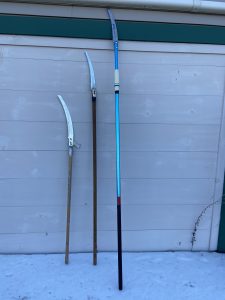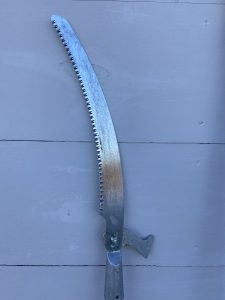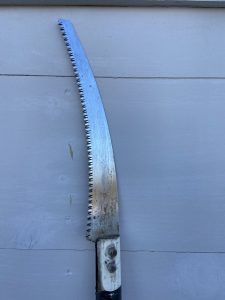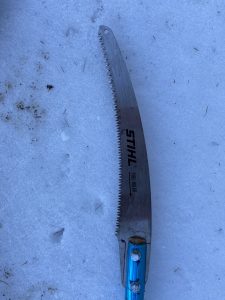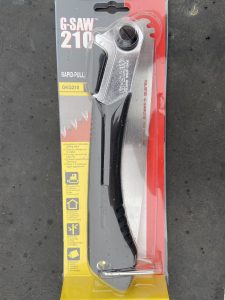POLE SAWS, HAND SAWS & FOLDING SAWS
A number of years ago, the tree care industry began embracing Japanese made saws that have teeth with no “set” (or TRI EDGE), that cut on the pull stroke, and left a very smooth finish on the wood that they cut. (“Tri-Edge” is where the back and front of each saw tooth is sharpened as well as another bevel on the cutting tip of the tooth itself, for a total of three beveled edges. Tri Edge blades have no set to the teeth, resulting in a narrower kerf and overall quicker and smoother cut.) You can opt for the Silky brand, the pinnacle at the moment, and while paying top dollar, you will not likely be disappointed.
What follows are reviews of some of the alternatives that I have used.
Included are some modifications to the “pole” use that I would recommend to anyone invested in caring for woody plants of any size.
An arborist friend reminded me to not extend my reach too far when using a pole saw. Basically, don’t move too far out from what would be your shoulder width when sawing. Overtime, avoiding this simple rule could lead to rotator cuff injury.
SAMURAI. There are loyal devotees of this brand, but it just doesn’t get the overall praise that Silky does. At a much lower cost, they fit the bill for the average consumer, and are of a much higher quality than those found at most local retailers. Samurai also fills a niche, for when you want to make a flush cut at ground level, cut some rotting timber or just don’t want to risk dulling a more expensive saw blade that you would be depending on, when you are balancing high up in a tree. I cleared out some dying alder recently and found this ICHIGEKI model to be quite effective. With a lower upfront cost, compared to a Silky, (I paid about $30), I was more at ease about possibly damaging it. (A pricier model, the ICHIBAN, sells for around $60, has a thinner, tapered blade and cuts more quickly and smoothly). The scabbard for this model is poorly designed. The saw fits loosely in it and needs monitoring for that reason, but it is the cutting performance that I am interested in, and I find that to be adequate. It does leave a coarser finish than others but that’s a trade off for its aggressiveness.
Both of these outfits carry an extensive selection of the Samurai brand. Visit either of them if you feel a need to be mesmerized by the product line.
ARBsession.com in DePere, Wiscomsin.
Bishop Co. , in Whittier California.
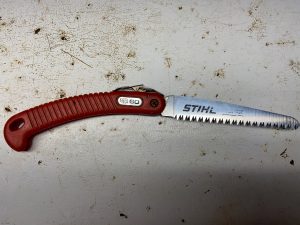 This FELCO Model 60 saw was my introduction to the new Japanese style blades. It was easy to climb into a tree with it stuffed in a back pocket, and the slight profile helped to remove branches that formed a narrow crotch angle. It made such incredibly smooth and fine cuts, that I sometimes carried it in my tool pouch to use as a plane, when I did some carpentry work. Seriously, this saw would shave wood like no other. Early on, there weren’t many other choices available but I didn’t like the high cost of a replacement blade and at some point felt the quality had shifted. Then I discovered that STIHL marketed a blade that fit, at a more reasonable price. Now after many years and blade changes, it is still serviceable, but I have mostly swapped it out for a slightly longer saw. This one is 6” long.
This FELCO Model 60 saw was my introduction to the new Japanese style blades. It was easy to climb into a tree with it stuffed in a back pocket, and the slight profile helped to remove branches that formed a narrow crotch angle. It made such incredibly smooth and fine cuts, that I sometimes carried it in my tool pouch to use as a plane, when I did some carpentry work. Seriously, this saw would shave wood like no other. Early on, there weren’t many other choices available but I didn’t like the high cost of a replacement blade and at some point felt the quality had shifted. Then I discovered that STIHL marketed a blade that fit, at a more reasonable price. Now after many years and blade changes, it is still serviceable, but I have mostly swapped it out for a slightly longer saw. This one is 6” long.
I misplaced two folding hand saws in recent months. I really like the convenience of carrying this type of saw in a back pocket, tool pouch or a backpack. I have been considering trying brands other than the Felco/Stihl or Corona models that I am familiar with. I have also avoided buying a Fiskars, or, at the other spectrum, a Silky. This particular purchase was an impulse buy, from a trip to Viking Lumber In Belfast. What follows is a crusty curmudgeonly review of this saw:
This saw is made in Japan. I have a great respect for the quality of saws coming out of Japan. The knockoffs, coming from Korea, Vietnam and China, seem to deteriorate, in that order.
The price was comparable to that of another replacement Corona, about $24.
The handle is probably heavier than it needs to be, but this is marketed as a multipurpose saw, so for the construction industry, the extra heft is a selling point.
There’s a ring at the bottom of the handle that helps to secure the blade closed, and could serve to help hang up the saw while climbing. I find that this makes it a little awkward to open and return to that locking position
While it locks securely into the open position, I have found it a little difficult to close, sometimes missing the slot that it needs to nest in. This occurs because the blade is thin and flexible. Having to fumble one handed in order to close this saw, while up in a tree, doesn’t appeal to me.
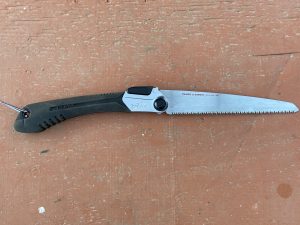 After opening it slightly, it will swing out and lock in place, with a quick snap of the wrist. I find that to be handy.
After opening it slightly, it will swing out and lock in place, with a quick snap of the wrist. I find that to be handy.
Adequate cutting performance is what most people would seek in a saw like this.
The (9 Teeth Per Inch) tooth pattern is less coarse than what I am used to. This makes for a less aggressive cut. While slower in action, it should work for most people.
The smoothness of the finished cut is less than what I anticipated from a blade like this. My original Felco, would leave an appearance, as if the wood was planed. With it also being stiffer, I could use it like a plane, and shave off an area that needed trimming, when used for carpentry.
Straight blades like these are handy for removing branches growing close together, like narrow “v” crotches. I will continue to carry something comparable while working around trees.
This particular saw will get passed along to my son for woodworking.
